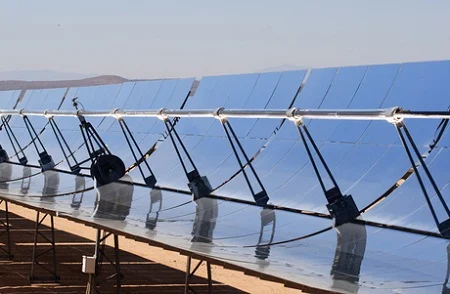MIT researchers say a hybrid solar-thermoelectric system they’re working on could provide a big advantage over conventional solar cells or solar thermal systems, particularly for household use.
Indeed, the new system would be capable of producing heat and electricity simultaneously – after a clever reconfiguration of the standard parabolic trough.

In a typical parabolic system (like the one pictured below), a curved mirror reflects sunlight onto a liquid-filled tube, and the hot water produced in that tube is used either to drive a turbine to produce power, or for heat for industrial uses or space heating.
The MIT team – Professor Evelyn Wang and grad student Nenad Miljkovic – is working on hybridizing the system to do both at once by modifing that tube with a series of concentric tubes within it.
Their first tube-within-the-tube would contain the thermoelectric material, which would take advantage of a temperature gradient to produce power. This thermoelectric system would have pretty low efficiency, the researchers say – but that’s OK, because homes generally don’t need too much electricity.
They need some, but they need a lot more heat – and the MIT design produces that by using an even narrower tube at the center of their device containing what’s called a thermosiphon.
This is a device that “draws heat away from the ‘cold’ part of a thermoelectric system,” according to MIT, “passively transferring heat from the thermoelectric cold side and alleviating the need to pump cooling fluid as in a conventional parabolic-trough system.”
The heat carried away by the thermosiphon could then be used to heat water for, well, hot water, but also space heating and industrial processes.
Abraham Kribus, a professor of mechanical engineering at Tel Aviv University in Israel who was not involved in this research, told MIT that in their paper on their work, Wang and Miljkovic describe “a fresh approach to solar energy conversion” but that some questions remain – as is to be expected.
“This is the situation at early stage with every nonconventional idea,” Kribus said. “Overall, the paper shows a nice start and a very capable team behind it.”






